Why training at a gym can be dangerous
If you take a look behind the scenes of the numerous gyms, you’ll often be horrified. Almost nobody would get behind the wheel of a car without a driving licence, but when it comes to fitness many of us just get going. Overconfidence and ignorance are common, and this is a matter of concern for experts. It’s not just the members of gyms who are clueless, in many cases even the trainers only know a little bit more. Young men who accept injuries and train like mad to achieve broad shoulders and lots of muscle mass are at particular risk.
Lack of basic knowledge
Almost half of all injuries among weight lifters can be avoided by warming up properly before training. Exercises are also done wrong or in a jerky way with weights that are much too heavy. This actively ruins your health simply because you think you know better or you’re shy about asking a trainer. Almost nobody cares what each muscle does and where it is. The most important thing is for the biceps to grow.
Lots of weight for lots of muscles
One of the fundamental problems of overambitious weight training for joints, tendons and ligaments is weights that are much too heavy. On the modern equipment in gyms, you often only train one muscle group for quick and visible success. This piles stimulus upon stimulus for thick biceps or a theoretically perfect figure. If you increase the weight you are lifting quickly, you will overload your tendons, ligaments and joints, because they fundamentally need more time than our muscles to adapt to the increasing strain placed on them. If you lift heavy dumbbells over your shoulders, you don’t just need strong muscles in your thighs, you also need fit knees that don’t go slack when they bend.
Where am I and where do I want to be?
The individual needs to know where they are to ensure targeted training. A basic check-up that examines the musculoskeletal system and the cardiovascular system for mobility and resilience is a basic requirement to be able to set a clear training objective. The rules will be different for amateur athletes who exercise regularly than for those returning to exercise again after a long break. A healthy dose of personal responsibility is also needed.
What does it come down to with a trainer?
The first step to fitness starts in the mind. This is why a qualified trainer will meet you exactly where you currently are. Even the best training will peter out into nothing if it doesn’t fit with your lifestyle and your needs. A personal trainer needs to be a skilled and trustworthy companion who will guide you to your entirely personal fitness objective in a motivating and empathetic manner. A short, one-off briefing about the gym is not enough. The exercises need to be regularly checked and the programme can be adjusted as needed. But almost nobody knows what their trainers can actually do, what training they have and whether their certificates are really worth anything. Many people just don’t care. Highly qualified sports scientists are mixed in with “fitness instructors” who have quickly trained at weekends and have a basic licence. In any case, it’s worth looking closer and asking who you’re working with.
Expect the best for your health. As is so often the case in life, it’s not about doing the right things but about doing things right.
What’s your experience of gyms like? Get in touch and tell me about it: petra.geisser@smoove-retreat.ch I’m interested to hear.

Petra Geisser

